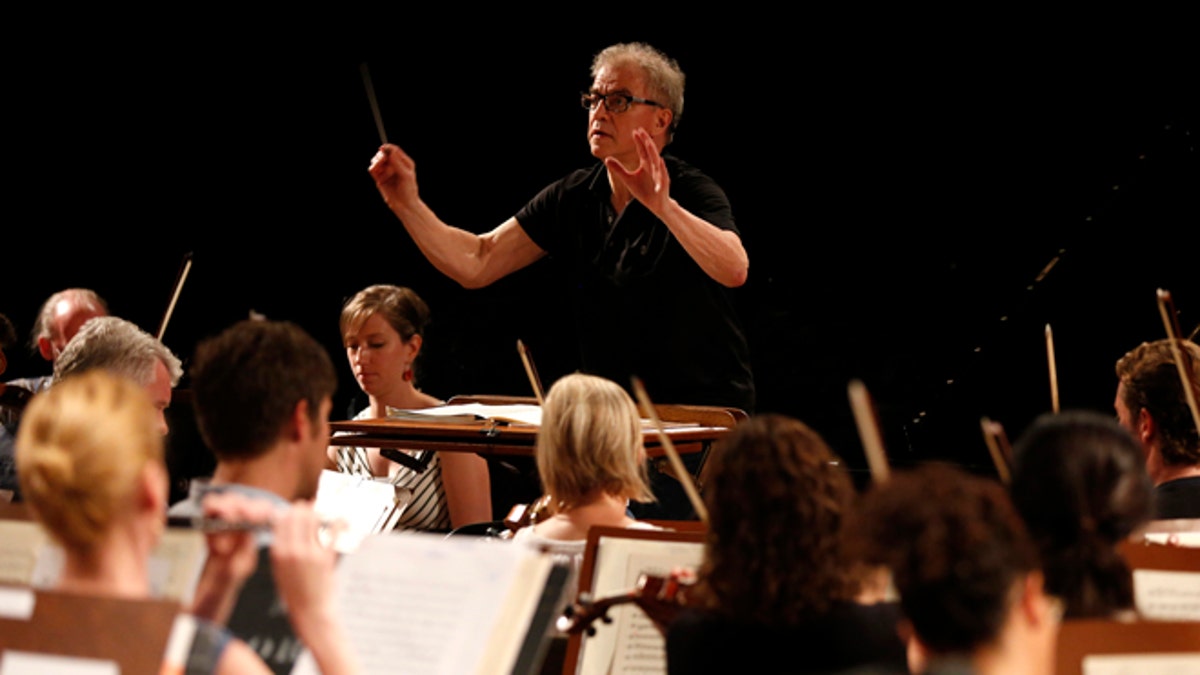
Minnesota Orchestra Music Director Osmo Vanska of Finland conducts a rehearsal in Havana, Cuba, Thursday, May 14, 2015. The Minnesota Orchestra also played Havana in 1929 and 1930, when it was called the Minneapolis Symphony. Fridays all-Beethoven program was a reprise of its 1929 repertoire, with performances of Overture to Egmont, Opus 84, Fantasy in C minor for piano, chorus and orchestra, Opus 80, and Symphony No. 3 in E-flat major, Opus 55. (AP Photo/Desmond Boylan)
HAVANA (AP) – The Minnesota Orchestra played to a sold-out house Friday night in the first performance in Cuba by a full professional U.S. orchestra since 1999, coming just months after the two Cold War rivals announced a thaw in relations.
Few of the visiting Americans speak Spanish, but "the universal language of music" was all they needed, said Mele Willis, the orchestra's artistic operations manager.
The performance at the 2,000-seat National Theater, which was broadcast live in Cuba and on Minnesota Public Radio, included famed Cuban pianist Frank Fernández and the Cuban National Choir. Fernández was presented with a bouquet, then pulled some of the flowers loose and handed them to a few of the Americans in the orchestra.
A thrilled crowded gave the concert a standing ovation. Omar Fernández, a Cuban who works for a Canadian travel agency in Havana, attended with his wife and young son. "We love music. And this is very important," he said when asked why he came.
Smaller groups of U.S. classical musicians have visited Cuba in recent years, but a 1999 visit by the Milwaukee Symphony Orchestra is believed to be the last by a major orchestra.
Friday's concert came a day after members of the Minnesota Orchestra held standing-room-only master classes with music students at a Havana high school and university. Students filled every seat, sat on floors, peered in through windows and videotaped the sessions with cellphones.
The Americans' lack of Spanish did not impair their enthusiasm. Trumpet player Bob Dorer gave a thumb's up and demonstrated trumpet technique by mouthing an "O'' after a spike-haired teenager, Antonio Díaz, performed. Shouts of "Bravo!" erupted after violin student Jorge Enrique Amado played a challenging modernist piece he composed. "We're very impressed," said Roger Frisch, a violinist in the orchestra who asked for a copy of Amado's piece.
"I'm not used to hearing high school students play at such a high level," agreed percussionist Brian Mount, who said he was "blown away" and "almost wanted to cry" watching the Cuban kids in a jam session.
Student Natali Chongo said it was a "privilege" to be coached on drumming four kettledrums by the orchestra's Peter Kogan. "The musicians of the U.S. and the musicians of Cuba always have friendship in their hearts," she said. "They need our music and we need their music."
The Cuban Ministry of Culture invited the Minnesota orchestra to perform as part of Havana's International Cubadisco Festival. "It is an extremely important moment," said Orlando Vistel, president of the Cuban Institute of Music.
The Minnesota Orchestra also played Havana in 1929 and 1930, when it was called the Minneapolis Symphony. Friday's all-Beethoven program was a reprise of its 1929 repertoire, with performances of "Overture to Egmont, Opus 84," ''Fantasy in C minor for piano, chorus and orchestra, Opus 80," and "Symphony No. 3 in E-flat major, Opus 55."
Another concert was scheduled for Saturday night along with a jazz performance by Minnesota players and Cuban musicians at the Havana Cafe.
The trip marks a healing for the orchestra, which is rebounding from a bitter labor dispute that included a canceled season.
Its tour has cost nearly $1 million, which was underwritten by Marilyn Carlson Nelson, an heir to the Carlson hotel company fortune, and her husband, Glen. The U.S. government gave special permission for a direct charter flight from Minneapolis to Havana for the event, putting four tons of equipment and 160 people on an Airbus 330.
Orchestra CEO Kevin Smith said the musical exchanges were "the most exciting part of the trip, along with the fact that it's happening in such a dynamic period in relations between the U.S. and Cuba."
